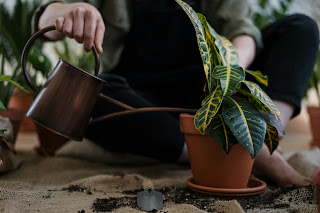Are you dreaming of fresh vegetables and beautiful flowers but struggling with limited space? Container gardening is your perfect solution! This gardening method has revolutionized how Americans grow plants in apartments, condos, and small backyards. Whether you're a complete beginner or looking to maximize your small outdoor space, container gardening offers endless possibilities for growing your own food and creating stunning displays right at home.
Why Container Gardening is Perfect for Modern Living
Container gardening brings numerous advantages
that make it ideal for today's lifestyle. First, it gives you complete control
over soil quality, drainage, and plant spacing. Unlike traditional in-ground
gardening, you can move containers to follow sunlight throughout the day or
bring them indoors during harsh weather. This flexibility is especially
valuable for renters who can't make permanent changes to their living space.
The mobility factor also means you can rearrange your garden
layout seasonally or when entertaining guests. Container gardens require less
weeding since you're using fresh potting soil, and they're much easier on your
back and knees compared to ground-level gardening. For urban dwellers dealing
with contaminated soil or poor drainage, containers provide a clean, controlled
growing environment.
Choosing the Right Containers and Materials
Success in urban gardening starts with
selecting appropriate containers. Size matters significantly – most vegetables
need containers at least 12 inches deep and wide, while root vegetables like
carrots require 18-24 inches of depth. Tomatoes and peppers thrive in 20-gallon
containers, giving their roots plenty of room to spread.
Material choice affects both plant health and your budget.
Terra cotta pots are attractive and breathable but dry out quickly and can
crack in freezing temperatures. Plastic containers retain moisture better and
are lightweight, making them perfect for balcony gardens. Fabric grow bags
offer excellent drainage and root aeration, plus they're collapsible for winter
storage.
Ensure every container has drainage holes to prevent
waterlogging. If your decorative pot lacks drainage, use it as a cachepot by
placing a draining container inside. This protects your surfaces while
maintaining proper plant health.
Soil: The Foundation of Container Success
Never use regular garden soil in containers – it's too heavy
and doesn't drain properly. Quality potting mix is essential for container
gardening success. Look for mixes containing peat moss or coco coir
for moisture retention, vermiculite or perlite for drainage, and slow-release
fertilizer for nutrition.
Mix your own blend by combining 1/3 quality potting soil,
1/3 compost, and 1/3 perlite. This creates an ideal balance of nutrients,
moisture retention, and drainage. For vegetables, add a handful of worm
castings per container to boost fertility naturally.
Containers dry out faster than ground soil, so adding
moisture-retaining crystals can help maintain consistent hydration. These
expand when watered and slowly release moisture to plant roots, reducing your
watering frequency by up to 25%.
Smart Watering and Fertilizing Strategies
Garden smart tips for watering focus on
consistency and proper timing. Container plants typically need daily watering
in summer heat, but always check soil moisture first. Stick your finger 2
inches into the soil – if it's dry, it's time to water thoroughly until water
drains from the bottom.
Install a drip irrigation system or self-watering containers
for vacation convenience. These systems maintain steady moisture levels and can
reduce water usage by 30-50% compared to hand watering. Smart irrigation timers
with weather sensors prevent overwatering during rainy periods.
Container plants need more frequent fertilizing since
nutrients wash out with regular watering. Use liquid fertilizer every 2-3
weeks, or incorporate slow-release granules at planting time. Organic options
like fish emulsion or compost tea provide gentle, consistent nutrition without
chemical buildup.
Top 10 High-Yield Vegetables for Containers
Maximize your urban gardening success with
these proven container performers:
Lettuce and leafy greens grow quickly in shallow
containers and provide continuous harvests. Cherry tomatoes produce
abundantly in large containers with proper support. Herbs like basil,
cilantro, and parsley offer fresh flavors and high value per square
inch.
Bush beans require no staking and produce
heavily in medium containers. Radishes mature in just 30 days
and work well in smaller pots. Peppers of all varieties thrive
in containers and produce for months.
Carrots grow well in deep containers, especially
shorter varieties like Paris Market. Swiss chard provides
colorful leaves throughout the growing season. Bush varieties of squash can
produce surprising yields in large containers. Finally, strawberries in
hanging baskets save space while providing sweet rewards.
Start with easy-growing options like lettuce and herbs to
build confidence, then expand to more challenging crops as your skills develop.
With proper containers, soil, and care, your small space can produce an
impressive harvest that saves money and provides the freshest possible
ingredients for your table.
Ready to start your container garden? Begin with 2-3
containers and gradually expand as you gain experience. Your future self will
thank you for taking this first step toward homegrown food independence!




Comments
Post a Comment